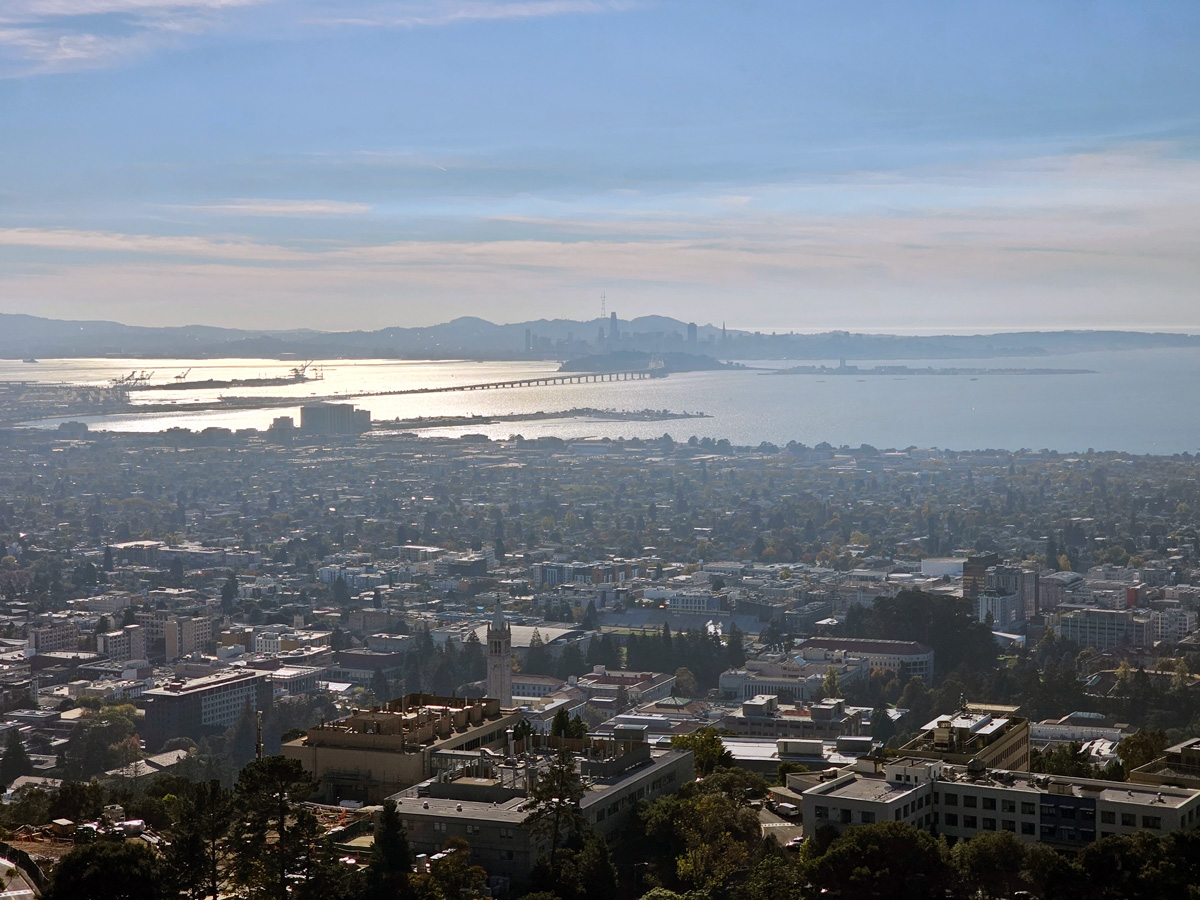
An aerial photo of the East Bay (foreground) and San Francisco (background) area. A new study details how historical redlining has influenced levels of native and non-native wildlife biodiversity four of California's largest cities. Photo by Christopher Schell.
Redlining, a discriminatory lending practice that originated in the 1930s and blocked people of color from getting mortgages in certain neighborhoods, has significantly altered the distribution of wildlife in four of California’s largest cities, according to a first-of-its-kind study published today in the Proceedings of the National Academy of Science.
Using data submitted to the iNaturalist citizen science platform, researchers from the University of California, Berkeley, and the Lincoln Park Zoo's Urban Wildlife Institute found that historically redlined neighborhoods in Los Angeles, San Diego, San Francisco, and Oakland have lower levels of native and non-native wildlife biodiversity compared to greenlined neighborhoods across each city. They also uncovered large differences in the types of mammals, birds, insects, and other species found in green and redlined neighborhoods.
“There are stark differences in habitat complexity between greenlined and redlined neighborhoods across the state,” explained lead author Cesar O. Estien, a graduate student in the lab of Environmental Science, Policy, and Management (ESPM) professor Christopher Schell. “Old redlined neighborhoods in California are still burdened with environmental quality issues, so it’s not surprising that they have less wildlife biodiversity than predominantly white, greenlined neighborhoods.”
Though redlining has been prohibited for decades, a growing body of research shows how its racist legacy continues to disproportionately affect Black, Latinx, and marginalized neighborhoods. Formerly redlined neighborhoods across the country are grappling with the amplified impacts of the climate crisis as well as disparities in neighborhood air quality, exposure to oil and gas wells, and infant and maternal health.
While recent studies have uncovered the influence of redlining on urban bird biodiversity in Los Angeles and biodiversity data, Estien and his co-authors—who include Schell, Professor Rachel Morello-Frosch, postdoctoral researcher Christine Wilkinson (PhD ’22 ESPM), and Urban Wildlife Institute ecologist Mason Fidino—sought to understand the long-term ecological consequences of redlining on various kinds of wildlife.
“Diverse urban wildlife populations play a huge role in the overall health of our cities' ecosystems,” explained Fidino. “The more we understand the effects of historically discriminatory practices like redlining on urban biodiversity, the more we can do to correct these shortcomings going forward. After all, access to nature and wildlife is important for human health and well-being.”
The authors analyzed more than 100,000 research-grade observations submitted to iNaturalist between 2017 and 2022 and used digitized Home Owners’ Loan Corporation (HOLC) maps to determine whether the observation occurred in a previously redlined neighborhood. Their findings revealed a consistent trend across each city, with redlined areas consistently exhibiting lower overall biodiversity than greenlined areas. The highest disparities were found in San Francisco and San Diego, with five to ten times more species present in greenlined neighborhoods than their redlined counterparts.
“San Francisco’s older, more established neighborhoods like the Presidio or Lake Merced tend to have a lot more street trees and native and non-native vegetation in gardens and yards,” Estien said. “It’s a notable difference when you compare it to the Tenderloin, Dogpatch, or Bayview areas.”
Although biodiversity in Oakland and Los Angeles was richest in non-greenlined areas, the authors still found that redlined neighborhoods host half as many native and non-native species as the cities’ greenlined communities. The study also found that an individual is more likely to encounter a greater diversity of species—and observe them with less effort—in California’s greenlined neighborhoods than in non-greenlined neighborhoods.
“We’ve heard from residents who have lived in the Oakland flats across the years that they’d never expect to see carnivores beyond raccoons or opossums or birds beyond pigeons and house sparrows,” Estien said. “But when you go up to the hills, your likelihood of running into charismatic or forest-dependent birds and mammals, like bobcats, goes way up.”
The authors stress the importance of understanding the connection between historical policies and urban biodiversity disparities, particularly in the context of redlined neighborhoods in California, which are predominantly inhabited by marginalized populations. The hope is that cities, which are increasingly recognized as biodiversity hotspots, will utilize these findings to drive equity-informed conservation efforts.
“Whether it’s restoring green space in redlined neighborhoods or preventing the displacement of wildlife in more biodiversity-rich areas, there is a lot that cities can do to ensure that both humans and wildlife have access to better environments,” Estien said.
The research was supported by the National Science Foundation Graduate Research Fellowship (DGE-2146752), the National Institute of Environmental Health Sciences (P42ES004705), and the Schmidt Science Fellows in partnership with the Rhodes Trust.
